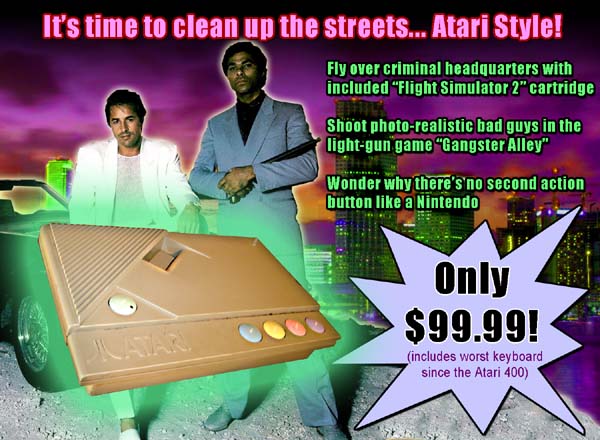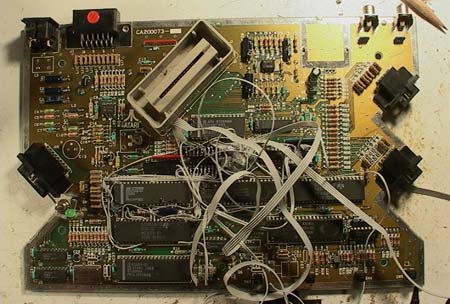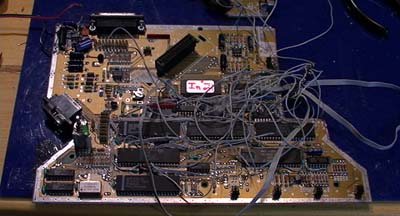|
|
|||||
"Making Of" Story After building my very first portable,-the Atari 2600 VCSp, back in 2000 (ever notice how awkward of a year that is to say?) I had a couple of "dream projects" to follow it up with. One was a Nintendo portable, which strangely took 4 years to manifest itself. The other was something I consider impossible at the time - an Atari 800 computer laptop. My ultimate dream portable! A little back-story... The Atari 800 was my first computer ever and also my first "gaming system" This was back when I was 11 years old I believe. Yes Atari tried to make people think it had educational purposes and all that but let's face it - the 800 had some AWESOME games and that's what people remember it for. Of course I tried my hand at programming the thing - again to make games. I never got past BASIC but that didn't stop me from wasting more hours than I'd care to admit plugging away at it. Some of my stuff was, well, playable (see "Stripfunmaze" demo), most of it never finished. Actually I learned a lot of basic computer concepts that I feel really gave me and edge 10 years later when I got into graphics design and the kind of stuff I do now. But anyway...
I used my old beige 800 all the time and actually kept it actively hooked up from when I got it in '87 up til '96 when it finally conked out. The video card of all things! (aka ANTIC) Then while looking for movie props in a junk store I found a "new" Atari 800 and they charged me an entire $2 for it! I used the ANTIC card from it to refurbish my original 800 and it was brought back to life! Even now it sits next to me on the same desk as my "real" (ha) PC. That thing is a tank! I bet it could effectively stop most small arms fire at least! So I guess I've established I'm a fan of the system. As with the 2600 I wanted to "do something" in honor of it. The natural idea was to make a laptop version but this idea had some major hurdles, much more than say a 2600 portable. Such as: 1) Screen. Needs to be decent-sized, and you can't use laptop screens, the format is completely different (Ataris of course use old RF switchbox or composite video signals) 2) Power supply. Needs to, well, work. And fit. 3) Which Atari to use. Can't be a 1979 "tank" model like mine. An 800XL or XE Game System? (XEGS) 4) Disk drive! How the heck do you make an old 5.25" disk drive portable? (answer: you don't, without a wheelbarrow) I'll discuss how I got around each hurdle in the order I hurdled them... I started this project in late spring of 2003 so it's been a long time coming! Disk Drive Replacement - Summer 2003 Not only were the old Atari disk drives hard to find (working) but the disks themselves seemed to fail after a while. I dunno - I had a 1050 and an 810 and they both had problems of some sort and eventually died. My first idea for the laptop was to use some sort of modern [PC] laptop hard drive since they were small. Naturally this would require some sort of "Atari-to-IDE" interface, so I decided to type that into a search engine and see what popped up. I was actually kind of surprised when something DID come up - a site called "Mr Atari's Homepage" This guy had created what he called "MyIDE" interface which, well, lets your Atari 8-bit computer use an IDE hard drive. You can build it yourself inside the computer (internal) or buy a cartridge version from him (external). I decided to build my own of course (it's actually pretty simple) but it did require a new OS chip. (operating system, similar to a BIOS chip today) Mr. Atari had made a new OS that acts like the old but also has the hard drive support built in, so the machine thinks it's just a really big disk drive. This allows you to boot right up from the hard drive if you wish. Pretty slick, if you're into the Atari computer at all you should definitely check his site out. So I ordered an OS chip from Mr. Atari, got the other parts I needed off Digi-Key and found myself an Atari XEGS on eBay. I picked the XEGS because it was the last model Atari 8-bit computer (released as a "game system" but still a computer) Therefore I knew it'd be the smallest and easiest to hack. Plus it had those "awesome" pastel Miami Vice-colored buttons...
I also got myself this cool thing called an "SIO2PC" cable. It connects to your Atari's disk drive port and the other end goes into your PC. Your PC then "emulates" a disk drive (or anything else really) and the original Atari can't tell the difference. This allows you to run downloaded disk images on an actual Atari or make images of your actual disks before they die. I figured such a cable would be handy in this project (and I sure was right) Plus all my disk drives had conked out, as mentioned. Again if you still like your Atari computer you owe it to yourself to plunk down $25 for one of these. Once I had the parts I wired it all together, put in the new OS, attached an old 150 meg IBM Thinkpad drive and fired it up. Couple problems right away. First, no BASIC (should be built-in for an XE) I figured this was some sort of bug and just plugged in my old BASIC cartridge from the 800 for the time being. This allowed me to run the disk drive detection program (off the PC using the SIO2PC cable) but problem was it didn't work. No drive detected. I thought I had a working laptop drive but perhaps I was wrong...
Here you can see the XE motherboard, complete with most everything it originally came with from the factory. I hadn't begun to chop stuff off but I did have the IDE interface hooked up (hint: it's all the scraggly wires) The basic idea was to keep everything flush, or no higher than, the highest things on the motherboard. In this case that'd be the main IC's and capacitors. I knew when this thing got "laptop-a-rized" I'd need it as thin as possible. But of course that didn't matter yet because the drive detection wasn't working. So while I waited for that problem to magically fix itself I decided to start hacking. Even back then I knew this would be the ultimate hard-core project of my game-hacking career, so I threw out all the stops - I decided to remove an entire laptop hard drive-sized chunk of the board so a drive could lay flush alongside it.
There it is - with the upper right hand chunk missing. There wasn't much there anyway, just the RF box, A/V jacks and joystick ports. Well, that is sort of a lot - I guess I did end up doing a good deal of "surgery" to repair all the traces that were cut off from the procedure. Shoot, I can't quite recall, it was over 2 years ago. Still I made sure everything was flush and flat so it wouldn't get in the way later. Of course in the final design this empty space ended up being used for the batteries instead of a hard drive but that's another story. I replaced the original SIO (disk drive) port with a more modern DB25 printer port (like on a PC). Mostly because it was thinner. I built an adapter that plugs into it when I want to use original equipment or my SIO2PC cable. Alas, summer flew by and I knew my dream of taking an Atari 800 XE laptop to Classic Gaming Expo '03 was going down the drain. The project fell by the wayside... adrift in a sea of... eh, adriftness until...
CHAPTER 2 -
Compact Flash adapter to the rescue! (Supposedly)
|
|||||



